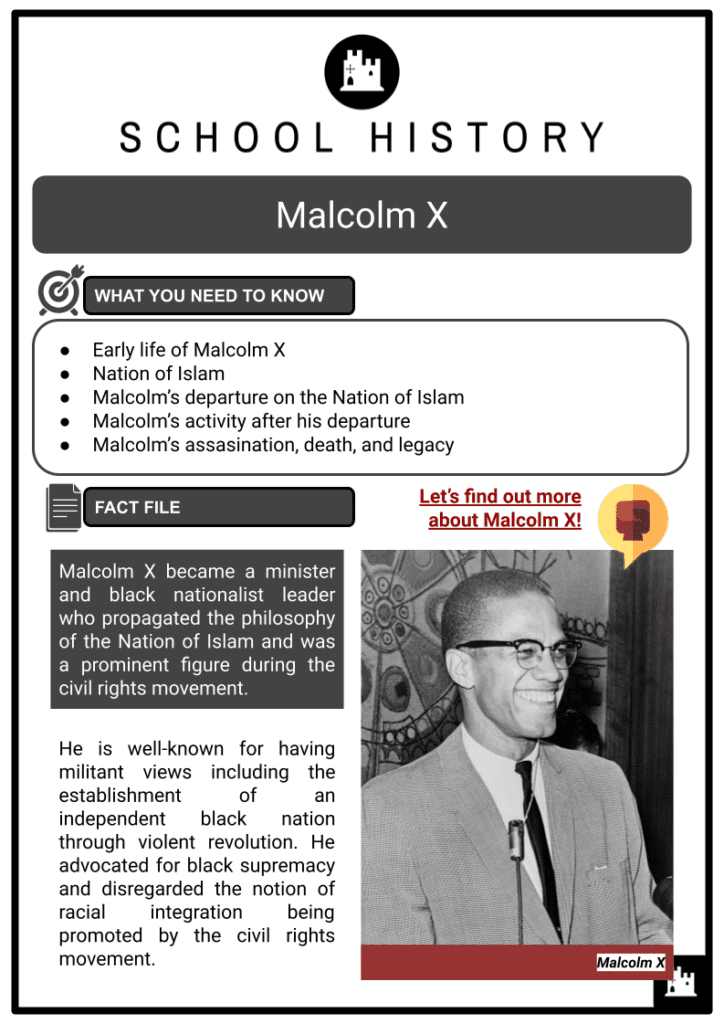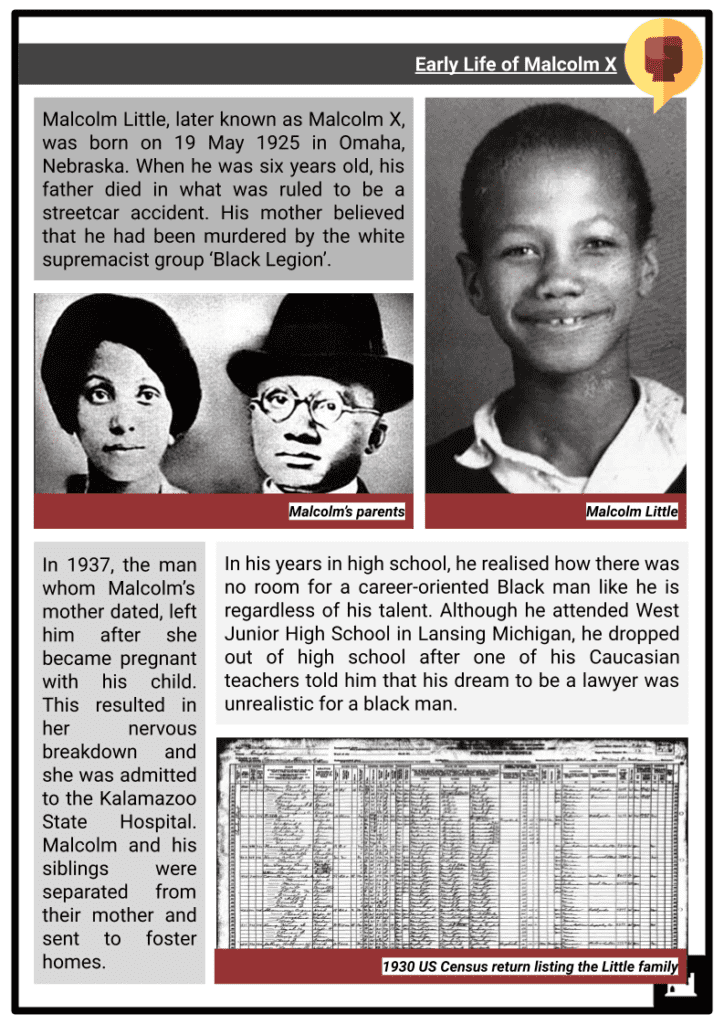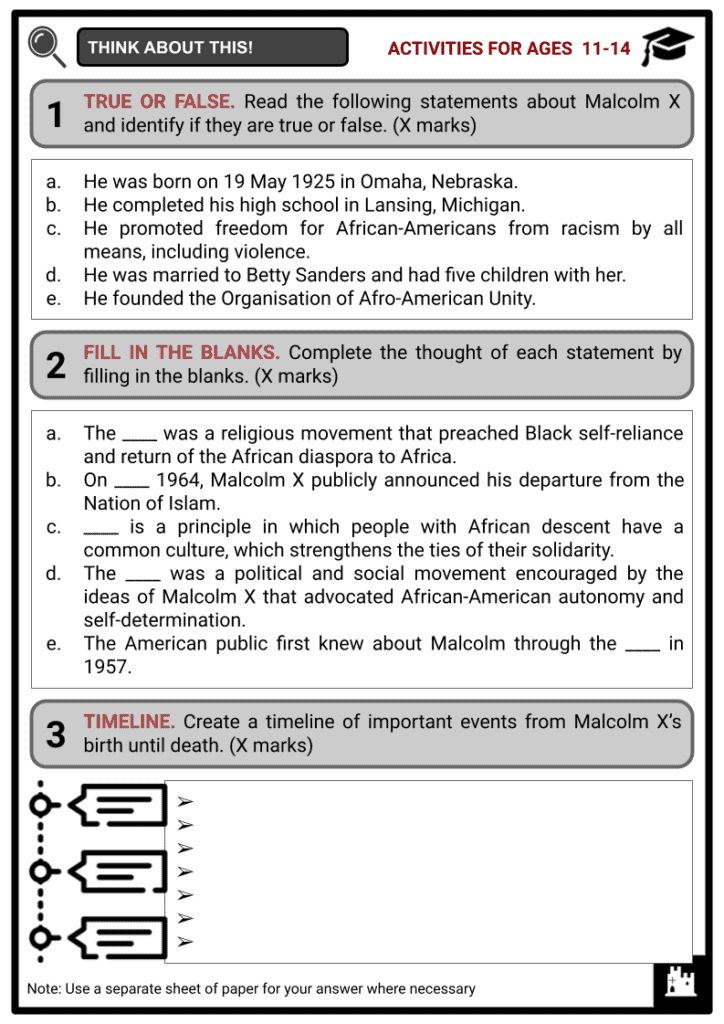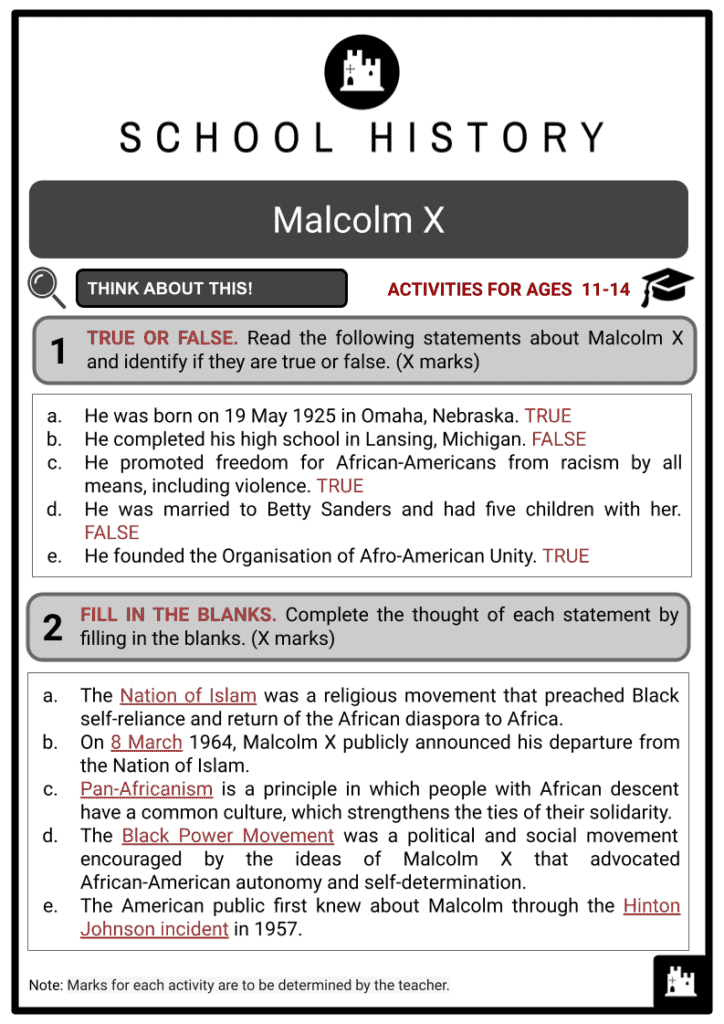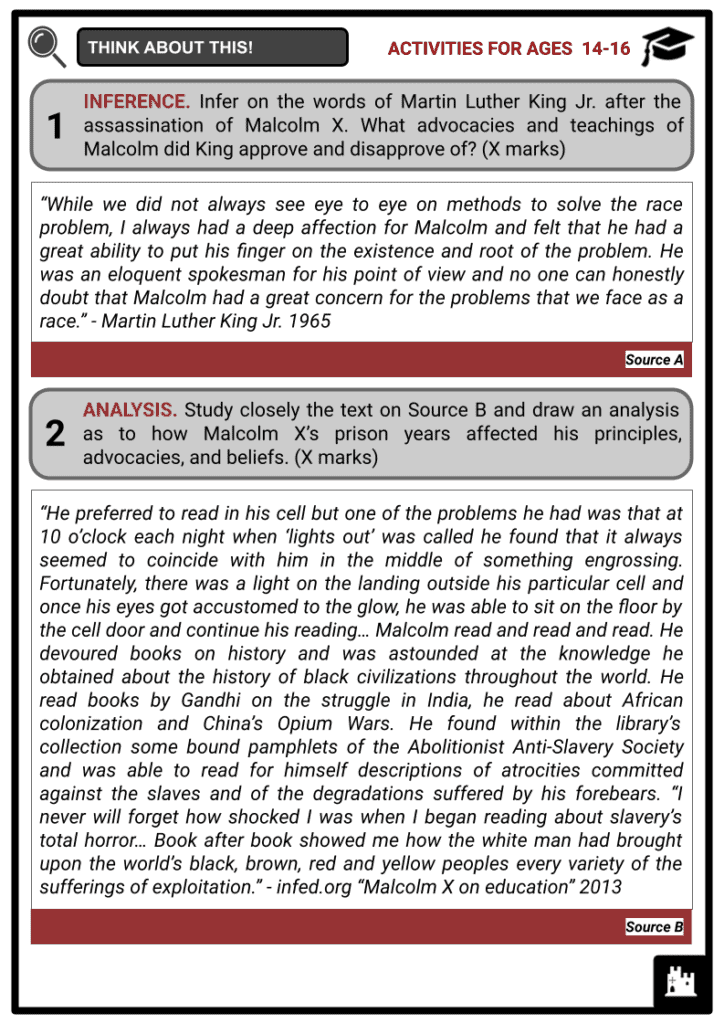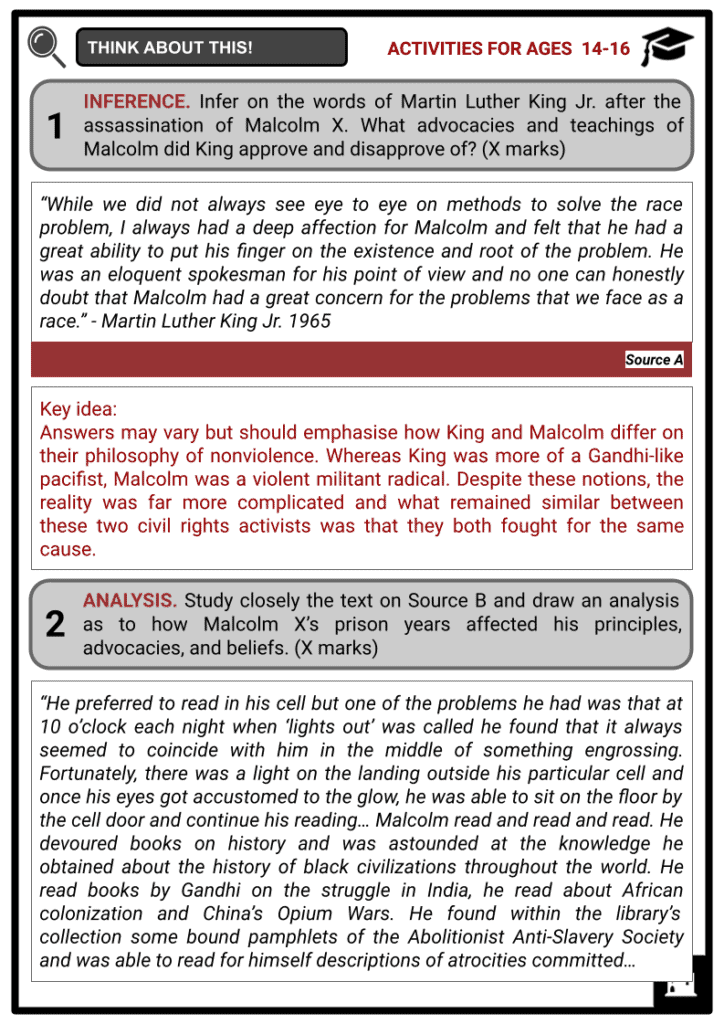Malcolm X Worksheets
Do you want to save dozens of hours in time? Get your evenings and weekends back? Be able to teach about Malcolm X to your students?
Our worksheet bundle includes a fact file and printable worksheets and student activities. Perfect for both the classroom and homeschooling!
Summary
- Early life of Malcolm X
- Nation of Islam
- Malcolm’s departure on the Nation of Islam
- Malcolm’s activity after his departure
- Malcolm’s assasination, death, and legacy
Key Facts And Information
Let’s find out more about Malcolm X!
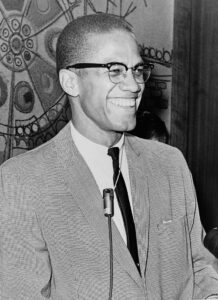
Malcolm X became a minister and black nationalist leader who propagated the philosophy of the Nation of Islam and was a prominent figure during the civil rights movement. He is well-known for having militant views, including the establishment of an independent black nation through violent revolution. He advocated for black supremacy and disregarded the notion of racial integration being promoted by the civil rights movement.
Early Life of Malcolm X
- Malcolm Little, later known as Malcolm X, was born on 19 May 1925 in Omaha, Nebraska. When he was six years old, his father died in what was ruled to be a streetcar accident. His mother believed that he had been murdered by the white supremacist group ‘Black Legion’.
- In 1937, the man whom Malcolm’s mother dated, left him after she became pregnant with his child. This resulted in her nervous breakdown and she was admitted to the Kalamazoo State Hospital. Malcolm and his siblings were separated from their mother and sent to foster homes.
- In his years in high school, he realised how there was no room for a career-oriented Black man like he is regardless of his talent. Although he attended West Junior High School in Lansing Michigan, he dropped out of high school after one of his Caucasian teachers told him that his dream to be a lawyer was unrealistic for a black man.
- After giving up on his education, Malcolm worked on a variety of jobs in Roxbury. In 1943, he moved to New York City’s Harlem neighbourhood where he worked on the New Haven Railroad. Here, he engaged in illegal activities such as gambling, robbery, and drug dealing, to survive.
- Although Malcolm was summoned by the local draft board for WWII military service, he was declared to be mentally disqualified after feigning so. In 1945, he went to Boston and committed a series of burglaries on rich white families with four other accomplices. In 1946, he was arrested and served an 8-10 year sentence at Charlestown State Prison. Two years later, he was transferred to the Norfolk Prison Colony.
Nation of Islam
- While in prison, Malcolm’s siblings wrote to him about the Nation of Islam, a religious movement that preached Black self-reliance and return of the African diaspora to Africa. Initially, he showed little to no interest in it, but after his brother Reginald visited him and described the teachings of the movement, he became receptive to its message, including the belief that white people were ‘devils’.
- In 1948, Malcolm wrote to the leader of the Nation of Islam, Elijah Muhammad. Soon enough, he became a member. It was then that he changed his name to Malcolm X. After his parole in 1952, he visited Muhammad and was named assistant minister of the Nation’s Temple Number 1 in Detroit the year after. He later expanded Temple Number 12 in Philadelphia and was selected to lead Temple Number 7 in Harlem.
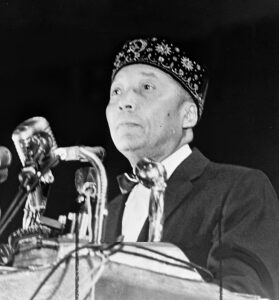
Elijah Muhammad - While in the Nation of Islam, Malcolm became more vocal of his principles and advocacies. He promoted freedom for African-Americans from racism by all means, including violence. Being a powerful speaker with a large and impressive physical presence, he was able to successfully recruit a large number of members on behalf of the organisation. By 1953, the FBI began a surveillance of him for his possible communist associations to his rise in the Nation of Islam.
- In 1955, Malcolm met Betty Sanders who joined the organisation the next year. Two years later, Malcolm proposed and was wed to her. The couple had six children. It was in 1957 when the American public first knew about Malcolm through the Hinton Johnson incident. Johnson was a member of the Nation of Islam who was beaten by New York City police officers. He was battered so severely that he suffered from subdural haemorrhage and brain contusions.
- Malcolm went to the police and demanded to see Johnson. Although the police initially denied of Muslims being held, they were pressured by the number of people that came with Malcolm and so allowed the latter to speak to Johnson. He then arranged an ambulance to take him to Harlem Hospital.
- By the time Johnson was returned to the police, more Muslims, still led by Malcolm, came for him and gathered at the police station.
- Johnson, however, was still not bailed and police were strict in not letting him go back to the hospital until his arraignment. The grand jury also declined to indict the police officers that beat Johnson up. This led Malcolm to send an angry telegram to the police commissioner. It was then that the police department assigned undercover officers to infiltrate the Nation of Islam.
- Advocacy and teachings of Malcolm X:
- White people are ‘devils’.
- Demise of the white race is imminent.
- Black people are the original people of the world.
- Freedom of African-Americans from racism should be achieved by all means, including violence.
- The black nation should be separate from the whites that are destined for divine destruction.
- By the late 1950s, Malcolm’s prominence increased and his comments on several issues were being reported by the media. He was even featured in the 1959 New York City television broadcast about the Nation of Islam. In 1960, he was invited to the official functions of African nations where he met Ahmed Sékou Touré of Guinea, Kenneth Kaunda of the Zambian African National Congress, Gamal Abdel Nasser of Egypt, and Fidel Castro of Cuba.
Departure and Activity after the Nation of Islam
- In 1961, violent confrontations erupted and tensions were raised between the South Central Los Angeles police and the Nation of Islam. By 1962, LAPD officers shoved, beat, and shot Muslims and raided their mosque. Many Muslims were indicted but no charges were laid against the police as it was ruled that their killings were justified. This prompted Malcolm to demand action and take violent revenge against the police.
- Elijah Muhammad denied approval of Malcolm’s plan, however, which prompted a turning point in the deteriorating relationship between the two. Rumours would later circulate of Muhammad’s extramarital affairs with young members of the Nation of Islam which was a serious violation of the organisation’s teachings. Malcolm, in a series of national TV interviews, provided testimonies confirming Muhammad’s multiple counts of child rape.
- On 8 March 1964, Malcolm X publicly announced his departure from the Nation of Islam. Malcolm converted to Sunni Islam and began promoting racial integration. He expressed his interest in working with other civil rights organisations and founded Muslim Mosque, Inc. and the Organisation of Afro-American Unity (OAAU) advocating for Pan-Africanism, a principle in which people with African descent have a common culture, which strengthens the ties of their solidarity.
- In April 1964, Malcolm flew to Jeddah, Saudi Arabia for his Hajj or pilgrimage to Mecca. At the end of his rituals, he was able to have an audience with Prince Faisal, where he later said that seeing Muslims, of all colours, come together in unison and interact as equals led him to see Islam as a means to overcome racial problems.
- During the Civil Rights Movement, Malcolm X was one of the activists at the forefront. He was often compared alongside Martin Luther King Jr., who took a more nonviolent approach against racism. King was more of a Gandhi-like pacifist, while Malcolm was considered a violent militant radical. Despite these notions, the reality was far more complicated.
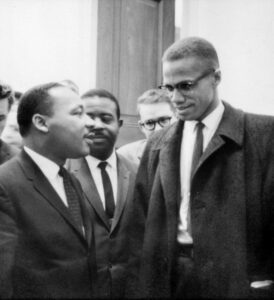
Malcolm X with Martin Luther King Jr. - For all of Malcolm’s militant talk, he did not actually advocate attacking the government, rather he urged blacks to be ready to defend themselves violently if there was a need to be. He encouraged blacks not to kill whites to affect change, but rather only show that they were not afraid to fight back in worst case scenarios. He was otherwise known to actively defuse situations where his supporters were getting too unruly.
- King, on the other hand, was not quite as averse to guns as what he is perceived to be. Despite him organising many nonviolent protests, he fully brought into the idea of ‘just in case’ firepower given his history of being a man of the South, fighting against acts of terrorism. Despite the mainstream headlines that generalised these two civil rights activists, it is to note that humans aren’t slogans and that real life demands that every activist has a practical side.
Assassination, Death, and Legacy
- After Malcolm’s departure from the Nation of Islam, his conflict with them only grew and he was repeatedly threatened. On 21 February 1965, while preparing for his speech at the Audubon Ballroom in Manhattan, someone from the audience yelled and his bodyguards tried to quell the disturbance.
- As they were kept busy, a man rushed forward and shot Malcolm once in the chest, followed by two other men who charged a stage firing. At 3:30 pm, he was pronounced as dead after arriving at the Columbia Presbyterian Hospital. The gunmen were confirmed to be members of the Nation of Islam.
- Malcolm X was known to be one of the most influential African-Americans in history, mainly credited for raising the self-esteem of African-Americans and reconnecting them to their African roots. He is also largely responsible for the spread of Islam in the African-American community.
- In the late 1960s, the Black Power Movement, a political and social movement that advocated African-American autonomy and self-determination, was encouraged by the ideas of Malcolm X. The movement introduced changes to African-American culture from hairstyles, clothing, music, art and even language use.
- The term “Black Power” was first coined by Stokely Carmichael, a civil rights activist and leader of the SNCC. The movement emerged as many African-Americans were dissatisfied with Martin Luther King, Jr.’s slow nonviolent protests. The movement ended in the late 1960s, as the United States’ focus turned to the Vietnam War.
- In the 1980s to 90s, Malcolm also influenced life among young people, including hip-hop groups like Public Enemy. His image was displayed in homes, schools, offices, and even T-shirts. A film about his life was also released as well as an adaptation of The Autobiography of Malcolm X.
- Several fictional characters that we know of today are also inspired by Malcolm, including Magneto from X-Men and Erik Killmonger from Black Panther.
Image Sources
- https://upload.wikimedia.org/wikipedia/commons/thumb/c/cb/Malcolm_X_NYWTS_2a.jpg/800px-Malcolm_X_NYWTS_2a.jpg
- https://upload.wikimedia.org/wikipedia/commons/thumb/d/d2/Elijah_Muhammad_NYWTS-2.jpg/800px-Elijah_Muhammad_NYWTS-2.jpg
- https://upload.wikimedia.org/wikipedia/commons/thumb/e/e1/MLK_and_Malcolm_X_USNWR_cropped.jpg/800px-MLK_and_Malcolm_X_USNWR_cropped.jpg

